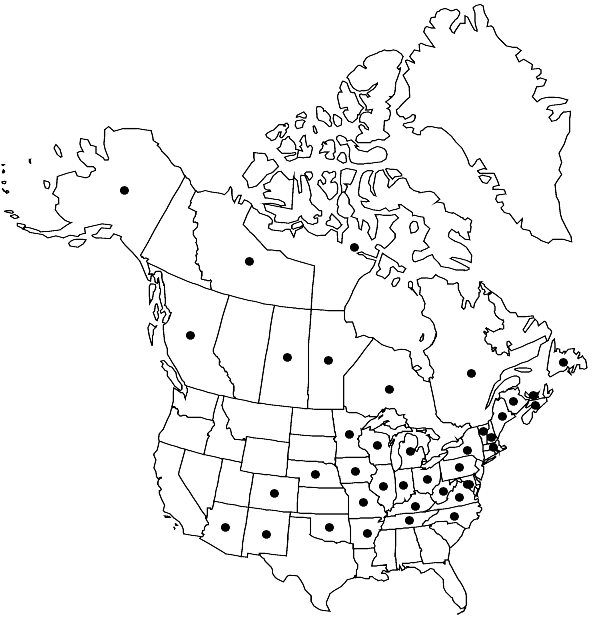Dicranum montanum
Sp. Musc. Frond., 143. 1801,.
Plants in dense tufts, usually with weak, clustered branchlets near stem apices with small, linear, erect-spreading, costate leaves, strongly crisped when dry, yellowish green to dark green, dull. Stems 0.5–3 (–5) cm, densely tomentose with white to reddish-brown rhizoids. Leaves erect-spreading, cirrate to strongly crisped when dry, smooth, (1–) 2–3 (–4) × 0.2–0.5 mm, concave below, subtubulose to keeled above, lanceolate at base, acuminate above to an acute apex, rough above on abaxial surface; margins irregularly serrate to serrulate in distal half of leaves; laminae 1-stratose; costa percurrent to shortly excurrent, 1/6–1/4 the width of the leaves at base, rough with papillae or teeth on abaxial surface in distal half of leaf, abaxial ridges absent, with a row of guide cells, two weakly developed stereid bands above and below, not extending to the leaf middle, adaxial and abaxial epidermal layers of cells not differentiated or with a few cells enlarged in both layers; cell-walls between lamina cells not bulging; leaf cells smooth below, mammillose or usually abaxially prorate or toothed in distal half of leaves, giving leaves a dull appearance; alar cells 1-stratose, differentiated or sometimes indistinctly differentiated, not extending to costa; proximal laminal cells rectangular to oblong-rectangular, not pitted or with few pits, (10–) 20–32 (–50) × (4–) 6–8 (–13) µm; distal laminal cells usually quadrate to short-rectangular, some cells transversely elongate, not pitted, (5–) 8–10 (–26) × (2–) 3–6 (–9) µm. Sexual condition dioicous; male plants as large as females; interior perichaetial leaves abruptly acuminate, convolute-sheathing. Seta 0.5–1.5 cm, solitary, rarely 2 per perichaetium, yellowish to reddish-brown. Capsule 1.2–2 mm, straight and erect to slightly inclined, rarely somewhat arcuate, smooth, striate when dry, light yellowish-brown; operculum 1–1.5 mm. Spores 12–24 µm.
Phenology: Capsules mature in spring.
Habitat: Rotting stumps and logs, tree bases (usually deciduous trees), occasionally soil or humus over rock, especially boulders and cliff ledges, in dry to mesic woods, rarely swamps
Elevation: 0-2800 m
Distribution

B.C., Man., N.B., Nfld. and Labr. (Nfld.), N.W.T., N.S., Nunavut, Ont., P.E.I., Que., Sask., Alaska, Ariz., Ark., Colo., D.C., Ill., Ind., Iowa, Ky., Maine, Md., Mass., Mich., Minn., Mo., Nebr., N.H., N.Mex., N.Y., N.C., Ohio, Okla., Pa., Tenn., Vt., Va., W.Va., Wis., Europe, Asia
Discussion
Dicranum montanum is one of the smallest species of the genus in North America. It can best be recognized by the small plants, often only 1–2 cm, the dull, yellowish green to dark green leaves that are strongly crisped when dry, the lanceolate, acuminate leaves that are subtubulose to keeled above, rough on the abaxial surface near the apex, and the straight, erect capsules. Also aiding in its recognition is the occasional presence of small, delicate, clustered branchlets with linear leaves that are readily detachable (probably a means of asexual reproduction), which occur near the stem apices. The detached leaves from the branchlets leave characteristic scars on the denuded portions. Dicranum montanum can sometimes be mistaken for D. flagellare, its closest relative, especially when the latter species does not have its typical flagelliform branchlets in the leaf axils or when they have been overlooked. Dicranum montanum has leaves with a keeled subula in the distal half, with a strongly papillose or toothed abaxial surface near the apex and distal leaf cells that are regularly quadrate. Dicranum flagellare, in contrast, has leaves with a tubulose subula above, with the abaxial surface usually smooth, and mostly short-rectangular leaf cells.
Selected References
None.